Socio-natural Disasters and Poverty: An Analysis from Emergency Decrees Issued in Chile
Elia Sepúlveda, Santo Tomas University
Roxana Contreras, Arctic Centre, University of Lapland
Alejandra Mora, Universidad de Atacama
1 Introduction
Geological or high impact climate phenomena, such as earthquakes, hurricanes, volcano eruptions and storms, have been part of the planet ́s history from the beginning and they belong to the natural cycle of the terrestrial ecosystem. Historically, humans have explained these events according to their cosmovision and the knowledge available at their present time (Capacci y Mangano, 2015; Descola, 2014).
However, the accelerated processes of industrialization and modernization have configured new physical and social representations of these phenomena (Larminat, 2016). The anthropic influence and the exponential increase of natural disasters since the 1980s (Centre for Research on the Epidemiology of Disaster [CRED], 2009) directly affect the understanding of a problem which is not only of geophysical origin. The social dimension of the problem has given rise to the concept of socio-natural disaster, highlighting this way the political, cultural and economic aspects (Hidalgo, Burgos and González, 2018; Alcántara-Ayala, 2016).
In 2018, according to CRED, a total of 315 disasters were counted, world-wide. Sixty-eight million people were directly affected by those events, and more than ten thousand deaths were attributed to them. The economic impact is estimated in approximately 132 billion dollars. Disasters related to climate were the most dominant, mainly, floods, storms and heat waves which affected mostly areas in Asia and America. The consequences of a disaster are mainly related to human affliction; for example, deaths, economic and material losses, and usually the need of international aid to face the catastrophe, besides the possible issuance of state of emergency (CRED, 2019).
Even though platforms for international agreements on disaster risk reduction provide useful tools to support mitigation and adaptation strategy planning, it is important to understand the disaster from multiple dimensions, especially regarding the local social scale, since it conforms a fundamental element (Marco de Sendai, 2015).
The political and social consequences of global change and the human transformations due to the Anthropocene, demand from social workers, who develop processes of social and communitary intervention, an improvement in their knowledge about risk and social resilience in the context and within the territories being intervened.
This study is an attempt to join the challenge of understanding, from the social point of view, the natural disaster phenomena, and to contribute by generating new knowledge to support the social practices and interventions mentioned above. For this purpose, we analyze the case of Chile, a country located in South America, which presents interesting characteristics regarding risk and exposure to natural disasters, due to its geographical location along the Pacific Ring of Fire, where most big earthquakes and volcanic eruptions occur. This makes Chile the most exposed country to natural disasters, among OECD members; according to The World Bank's report on natural disaster hotspots (2005), where 12.9% of the total surface and 54% of the population are exposed to three or more hazards (Dilley et al 2005; Bronfman et al, 2019). Moreover, Chile is exposed to a variety of disasters, such as droughts, earthquakes, tsunamis, forest fires and floods (CNID, 2016). According to the Global Climate Risk Index for the period 1997-2016 (Germanwatch, 2018), Chile presents an intermediate level of vulnerability to global change impact.
Commonly and historically, in the Global South, countries base their economy on the exploitation of natural resources, being mining one of the most typical examples. Ffrench-Davis and Díaz (2019) propose that since 2000 this production model shows a decreasing cycle in the production of goods, based on the extraction of natural resources. The degradation of ecosystems, the difficulty in their restoration and the ever-increasing socio-environmental conflicts, create tension and pressure on this socio-economic developing system.
In the Latin American context, Chile is the country with the highest incidence of socio-environmental conflicts related to mining (OCMAL, 2019). World-wide, and according to data provided by the Atlas of Environmental Justice (ICTA UAB, 2019), Chile is one of the 15 countries with the greatest number of active environmental conflicts. The case of Chile follows the same trend observed in the rest of the world. Natural disasters, exacerbated by anthropic factors, are globally increasing and creating tension between society and nature; threatening the environmental heritage of future generations.
The topic of territorial dispossession and displacement combined with the link between natural disasters and poverty become a central piece which allow us to swing to what Klein (2007) defines as the rise of disaster capitalism. Starting from these ideas, this study opens the following question: Is there in Chile a higher prevalence of natural disasters in regions with higher percentage of poverty?
Scientific evidence confirms the causal links between poverty and natural disasters (Lee & Tang, 2019). To understand this intersection and increase our comprehension of the social dimension of disasters from the specific point of view of territory, considering its geopolitical characteristics, helps us to answer our research question. We hope to better understand disasters by including other aspects like exposure, vulnerability, and capacity.
Social work and socio-natural disaster, entre desafíos y oportunidades. Social work and socio-natural disaster, between challenges and opportunities
The research of social work regarding natural disasters (henceforth ND), shows a growing interest in understanding the anthropic dimensions that comprise the relationship between the social and the natural. Krings, Victor, Mathias & Perron (2018), completed a scientometric survey of 497 peer reviewed articles that referred to both theoretical and empirical studies of social work and environmental subjects published between the years of 1991 and 2015. The authors found that the articles whose topics were natural disasters represented up to 35% of the total articles, and was the subject that predominated over others, such as natural resources, food security, and the development of sustainable technologies and policies.
In a review of the scholarship, Mason, Shires, Arwood & Borst (2017), evaluated the research of social work regarding global climate change. The survey of 112 articles revealed that the study of natural disasters - mainly extreme hydrometeorological events like hurricanes, typhoons, floods, and droughts - comprised more than 50% of the sample, which confirms the interest of social work in the consequences and impacts of ND in situations of climate change and the degradation of the planet.
Thinking of natural disasters from the point of view of social work, is to see the connections between society and nature, its geopolitics and intersections. Ecosocial work (Bell, Dennis & Krings, 2019); Boetto, 2017) starts from a holistic view of the reality from which we work, acknowledging the ecosystem as a fundamental component of our praxis. From said connection, it is possilbe to discover local and ancestral knowledge that is effective for risk management of disasters. This is an act of emancipation that questions colonial and neoliberal logic as well as dominant patriarchal narratives and practices (Jacobs, 2019).
The intervention of social work in cases of ND becomes an opportunity for our profession to consolidate its methodologies, technologies, and epistemologies. Dominelli (2015), states that social workers have a lot to offer, since they have a long history of experience in dealing with communities in the context of crisis and vulnerability. The ethical compononent, the action of empowerment, and the humanitarian focus of social work, are extremely valuable assets, that allow us to overcome the top to bottom logic, which often operates out of context when it comes to crisis situations.
The organization of social services is key to the creation and execution of effective policies of risk and disaster management. The former requires a broad dialogue in which the social workers can contribute the knowledge they possess about social well-being. Maglajlic (2019) claims that intervention in disasters must consider flexibility, the capacity to answer, and a constant vigilance in the face of oppression, both during and after the disaster. These are subjects that challenge the capacity of social work to design good practices that strengthen resilience, transparency, and a horizontal coordination between all interested parties (Van Heugten, 2014). However, these are very complex interventions, whenever a natural disaster reveals structural inequalities underlying our society, such as healthcare, housing, food security, and productive development.
Since the recognition that a disaster is always social, Das (2020) advises that social work must improve its strategies of designing inclusive policies in the management of disasters. Old methods and logic persist, barely connected with the context or hierarchies that limit the understanding of the phenomena in its cultural, identity, and political interactions. To overcome this logic, we need to consolidate strategies that, according to Jones and Truell (2012), and the Global Agenda for Social Work, which encourages regional/local spaces of action, involving the necessities and characteristics of each territory and community. No disaster is equal to another and the biophysical and anthropic phenomenon are intertwined in different ways, varying according to each socio-ecological system.
2 Socio-natural disasters and poverty
According to estimates of the World Bank, the effects of climate change (manifested usually through natural disasters) will cause, by 2030, that more than 100 million people to fall under the poverty line (Arga, Walsh, Rozenberg, Hallegatte, 2020). People affected by poverty are the ones who suffer the most losses when there is a catastrophe, as they are at higher risk of becoming sick from post-disaster induced diseases and usually must use a higher percentage of their income on expenses related to increased prices of food articles when agricultural zones have been affected.
Inequity and social inequality become manifest in territorial and geographical gaps which establish clear urban and rural order, mirroring class and power borders. In fact, the countries affected the most by disaster impact are precisely those located in the poorest areas of the planet, such as Bangladesh, Guatemala, Haiti, Honduras, Kenya and the African North-east (Bundnis Entwicklung Hilft, 2019).
Poverty increases, considerably, the risk vulnerability, therefore, studying or understanding disasters from the notion of social vulnerability has become an emergent research topic. This notion, refers to the potential damage a disaster can cause on a society; for example, human losses, loss of infrastructure, damage to productivity or the disruption of social order (Yan, Zhang and Zhang, J., 2017).
The specific topics considered by research articles in the field, and regarding the natural disaster/poverty duo, refer to the mutual impact of both problems on social development Sawada y Takasaki, 2017), taking into account the potential risks that arise from the combination of both phenomena in one territory (Lim, Loveridge, Shupp and Skidmore, 2017; Carter, Little, Mogues, and Negatu, 2007).
When a natural disaster occurs in a poor area, it originates and (or) strengthens problems which are proper of marginal or deprived spaces. There are articles which focus on aggravating factors such as the increase in mortality (Frankenberg, Sumantri, & Thomas, 2020), the emergence of black or illicit markets, (Dunlap y Golub, 2011), famines and food security, especially in zones affected by droughts (Balasubramanian, 2018), child labor and school dropout, (Vásquez and Bohara, 2010), malnourishment (Webb, 2003), mental health disorders and post-traumatic stress disorders (Fussell y Lowe, 2014).
Aid programs aimed to the affected communities are also a topic of research. For example, Wickramasinghe (2013), studied the role of the social protection systems in disaster management. Other articles follow the same line, considering public and private activities developed before and after a disaster (Park and Wang, 2017; Owens, Hoddinott and Kinsey, 2003).
Social aid programs are considered to be fundamental within mitigation and risk reduction strategies, especially when they rethink the relationship between aid and the methods used to deliver this help to the relevant communities; for example, Kapadia (2013) analyzes the case of applying such strategies, through actions related to the local capabilities.
Many studies focus on capital and social resilience of the poorest sectors, emphasizing the fact that the capacity for resilience, in the context of poverty, helps to create awareness about the impact of a catastrophe and it mobilizes people in search for family and personal well being, reducing this way the potential risks (Waters, 2016; Arouri, Nguyen and Youssef, 2015; Reininger, 2013). The results of these research studies show evidence of the influence of poverty on the outcome and causality of a disaster which demand a response from the development strategies and public policies in order to make progress towards environmental justice and equity.
The World Bank defines Chile as a high-income country. Chile has poverty levels which are clearly lower than the rest of Latin American countries; nonetheless, Chile is characterized by high social inequality which has been part of the history of the country, and which is part of a structural order in which territorial segregation, and power concentration persist, even though Chile has achieved much progress towards development in the last 30 years (PNUD, 2017).
Socio-natural disasters and their outcome, are no stranger to these conditions, and they find a vulnerability spotlight regarding poverty which needs to be investigated further, according to the specific needs of each region or territory affected by such disasters.
3 Methodology
The research questions proposed in the previous section give rise to the following objectives:
1. To determine the frequency, type and geographical location of the main natural disasters occurred in Chile between 1990 and 2017.
2. To study whether there is a relationship between the poverty index of the region and the natural disasters which have been declared by means of a decree mechanism issued by the authorities.
With the purpose of answering these, a descriptive documentary study was done by analyzing and classifying primary data (Arias, 2006) from the following sources: 1) Decrees of emergency issued in Chile between 1990 and 2017, and 2) the Chilean National Socio-economic Characterization Survey (from now on, CASEN) for the same period. CASEN is an instrument used by the Chilean State to measure poverty. The decrees of emergency authorized by the Ministry of the Interior were searched and reviewed for the period 1990-2017. The information is digitized and available in the database of the Library of the Chilean Congress and the information bank of Chile (www.ley.cl).
A decree of emergency is a legal mechanism provided by the Chilean Constitution. Article No. 39 indicates that constitutional rights and guarantees may be exceptionally restricted, in situations which severely affect the normal functioning of state institutions, such as wars and catastrophes. Article No. 41 states that the state of catastrophe or emergency may only be declared by the President of the Republic through the Ministry of the Interior, with the purpose of activating specific strategies to allow the allocation of resources and actions during an emergency. Those decrees become references, which allow to visualize the public impact and the effects on the daily functioning of communities and territories which have been affected by situations of emergency and also their post-disaster social disturbances. Disturbances refer to negative impacts which affect the access to public services, connectivity, habitability, and also refer to risk of life losses, health and public security.
The information obtained from each decree was copied to a table and classified according to the following variables: 1) Decree number, 2) Month and year of the disaster, 3) Type of event, 4) Administrative region where the community affected was located. One single catastrophic event may originate several decrees, especially when several areas are consecutively affected by the same event. For those cases, it was necessary to decide whether to count them as separate events or as one single event even though it originated separate decrees.
In order to make this decision, the following criteria were used:
· Media coverage in common.
· Coincidence between the time evolution and the maximum intensity of the event.
· Public and private aid, or aid campaigns deployed simultaneously.
· Same type of disaster.
· Neighboring communities or regions.
· Political and administrative decisions or common action protocols.
Once the data was classified following the criteria, it was possible to obtain a panoramic view of the natural disasters occurred in Chile, according to their type, frequency and regional distribution.
The second part of this study required the collection of poverty indices during the period considered (1990-2017). The information provided by the Chilean National Socio-economic Characterization Survey (CASEN) was used for this purpose. CASEN is an instrument utilized by the Ministry of Social Development of Chile to estimate regional and national poverty, by means of a national census. It targets family groups in urban and rural areas throughout Chile, using a stratified, cluster sampling method. It has been in use since 1985, with a frequency of 2 years, except for the period 2000-2009, when the interval was longer (3 years). CASEN is an important instrument for the State because it allows to develop or evaluate social programs, based on the information obtained from the survey.
Poverty is determined according to income. A person whose income is less than the minimum established in order to satisfy the basic needs, is considered to live under the poverty line. And the information is provided in terms of population percentage (regional and national).
The survey has experienced modifications during its existence, especially regarding the methods used to measure poverty. Until 2011, the same method, based on income poverty was used. In 2013, the concept of income poverty was re-defined in order to meet more stringent standards, and in 2015, the concept of multidimensional poverty was introduced, adding 4 dimensions, besides income poverty which continued to be measured. Therefore, the results from the period 1990-2011 and 2012-2017 are not directly comparable and must be analyzed separately.
CASEN provides poverty data every 2 years, mostly, and every 3 years during the period 2000-2009. But, because disasters occur almost every year, in order to correlate disaster occurrence with income poverty, it was necessary to estimate for every administrative region and also for the whole country, the percentage of people living under the poverty line, as defined by income poverty and the criteria of the corresponding period. This was done by linear interpolation, for each region and for the whole country, separately. To find the missing year data point (corresponding to the years without survey), the result of the latest survey and the next survey are used and a linear time evolution between those two is assumed. If at time t1, the percentage of people considered poor is y1, and at a later time t3 the percentage of people considered poor is y3, then, by finding the equation of the line that connects y1 and y3, we assume that the missing data (y2) corresponding to the year t2, between t1 and t3, will be found along that line.
Figure 1 shows an example of two interpolations performed over the period 1990-2003. First, an interpolation between 1992 and 1994 was done in order to estimate the poverty percentage corresponding to 1993, shown as a blue line; the red circle on the blue line represents the data estimated by this method, and as it can be observed, the behaviour is not only linear between immediate points, but it is a very good approximation over a longer period (1990-1996). The second interpolation corresponds to the interval 1998-2000, represented by a red line; the estimated value corresponding to 1999 is shown as a blue circle on the red line.
From the figure it can be noted that poverty experienced two decreasing behaviours since 1990 until 2003. The first period, 1990-1996 is characterized by a very steep slope, meaning that the rate at which poverty in Chile diminished was rather high. The second period, 1996-2003 is characterized by a less steep slope, nonetheless, poverty continues to decrease linearly, however the rate is slower than in the previous period.
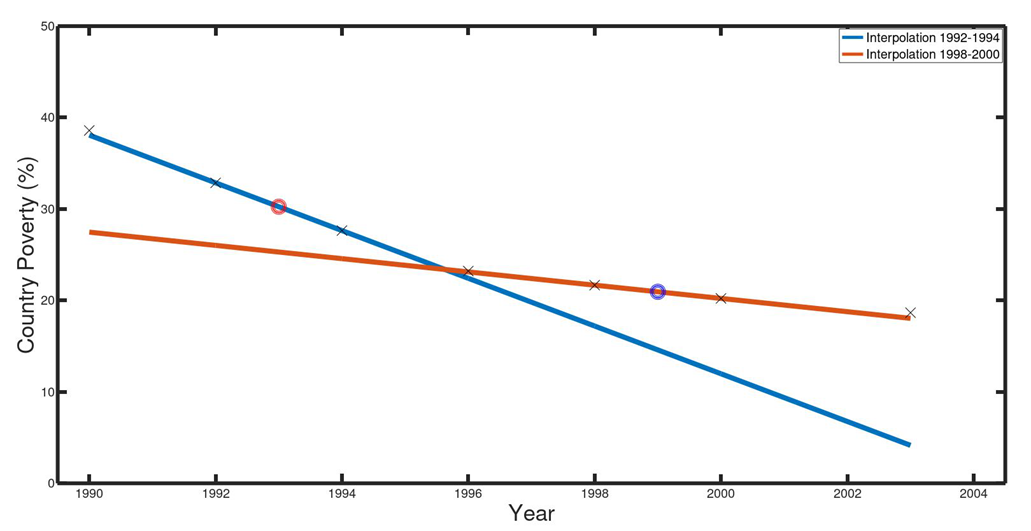
Figure 1. Linear interpolation to estimate values in years
when no data is available.
4 Results
It is important to highlight that the natural disasters considered here are defined only by means of decrees of emergency issued by the authorities in power. There have been many small-scale events which may still have a big impact on the affected communities in the short term, but they do not qualify for the application of this norm and therefore remain invisible to public opinion.
During the 27 years investigated, more than 100 decrees of zone of catastrophe were identified, of which 66 corresponded to single events (considering sometimes one event may cause the issuance of more than one decree). Two decrees were dismissed, because their origin was not natural; namely, Decree No. 718 (mine collapse in Atacama Region, 2010) and Decree No. 875 (mine collapse in Aysen Region, 2017). Therefore, a total of 64 events were counted.
This list of events does not intend to be absolute; instead, it is offered as an alternative method of classification, among other possibilities, such as technical criteria proper of geosciences, for example, or technical criteria commonly used in legal sciences.
Figure 2. Natural disasters, classified according to decree of emergency (1990-2017).
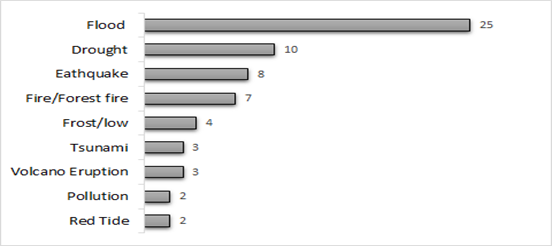
The list is dominated by hydrometeorological events and floods; 55% of the natural disasters declared as decree of emergency are of this type. Floods are typically preceded by heavy rainfall, which sometimes cause landslides on populated areas.
Figure 3 shows a map of Chile, with the regional distribution (from north to south) of the disasters, divided by type and illustrated by icons.
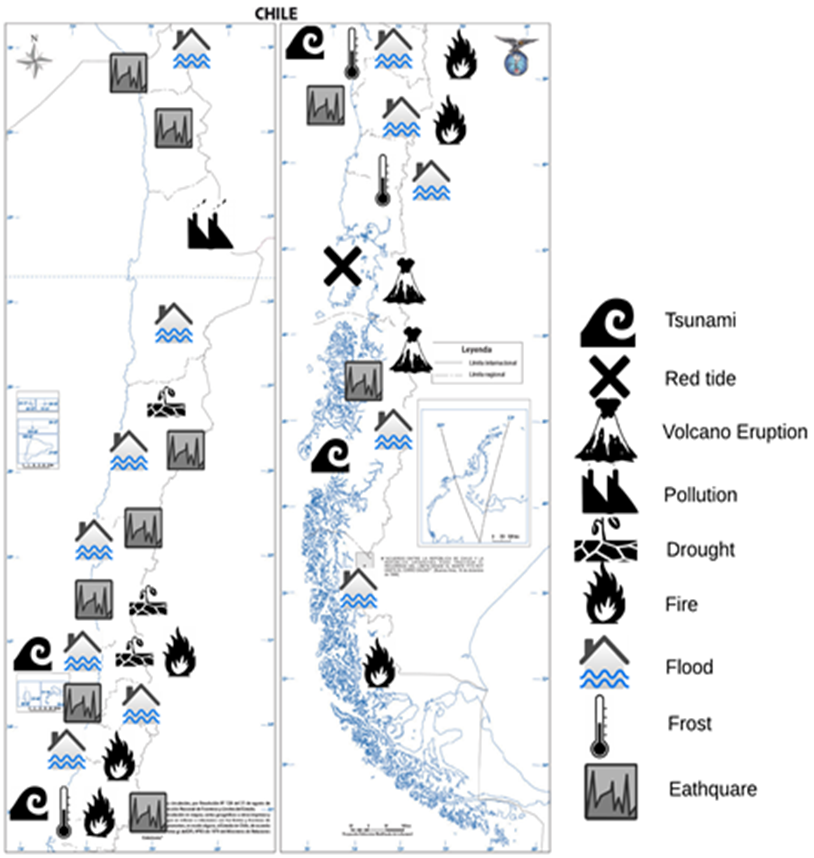 |
Figure 3. Type of disaster according to the issuance of decrees of emergencies from 1990 to 2017, organized by type and divided by administrative regions.
For each administrative region, the number of events were counted, to establish whether the events are evenly distributed throughout the country or whether some regions have higher concentration of events. It can be observed from figure 4, that the regions of Coquimbo and Valparaiso were affected by a higher number of events than the rest of the country. Hydrometeorological events and extreme events such as droughts are responsible for most of the decrees of emergency.
Figure 4, also helps understand the administrative divisions of Chile. As of 2017, the country, which is a unitary State, is divided into 15 regions, organized from north to south as shown in the figure (yet a new region was introduced in 2018).
Figure 4. Percentage of events per region in Chile, considering all the events occurred from 1990 to 2017
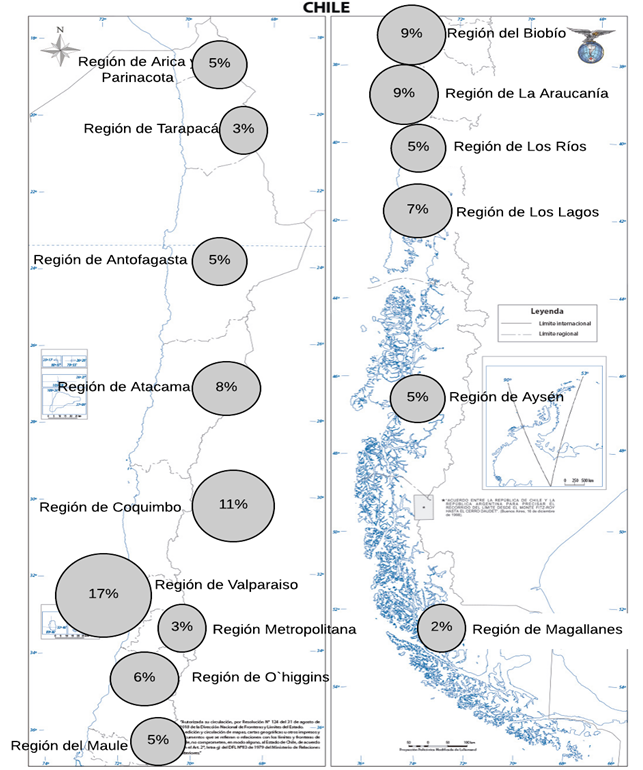
Figure 5 shows the mean values of the poverty index per region and for the whole country, divided into three decade periods. This helps understanding the time evolution of poverty in Chile in general. It has decreased in all the regions, following a similar trend.
Figure 5. Time evolution of the poverty index in Chile and its regions, dividing the period 1990-2017 into three decades.
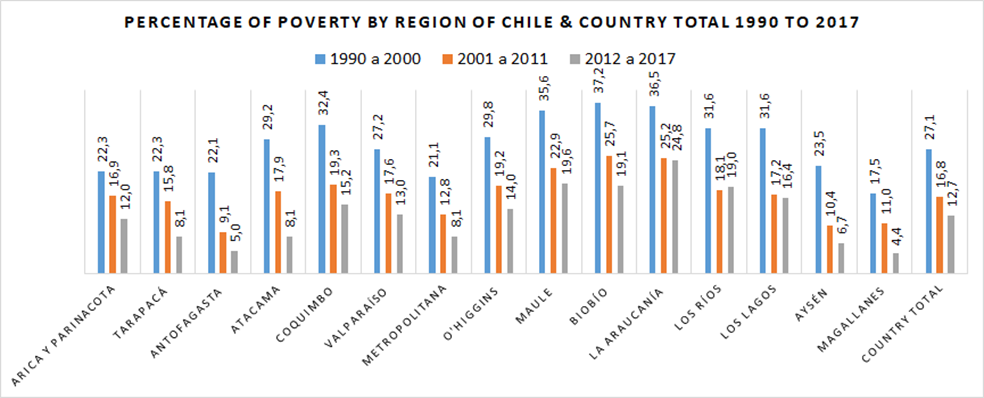
From 1990 to 2011 CASEN provides data on regional and country poverty based on one dimension of poverty (income poverty). In 2013 the method used to measure income poverty was changed for a more stringent method, therefore these two results cannot be compared directly and for this reason in this study, the period was divided into 1990-2011 and 2012-2017. Moreover, in 2015 the concept of multidimensional poverty was introduced, with 4 dimensions, besides income poverty (which was still based on the method introduced in 2013) and in 2017 a fifth dimension was added. However, because there are so few years of information regarding multidimensional poverty, and because the method of income poverty has remained consistent since 1990, except for the changes introduced in 2013, only this concept is considered in this study, in order to have consistency throughout the whole period.
The method used to determine whether a region is poorer or wealthier than the rest of the country, consisted in simply comparing the indices used for the country as a whole, directly to the indices of each region, and separating them into regions which present higher percentage of poverty than that of the whole country, and regions which present lower percentage of poverty than that of the whole country. The wealthier regions were called, for simplicity, “group A”, and the poorer regions were named “group B”. A region categorized as less wealthy than the country, does not necessarily imply that the region as a whole is underdeveloped, but instead it is a way to compare the distribution of income within the country, and of course it would indicate that in this particular region, the percentage of people below the poverty line is higher than the average for the country as a whole.
Between 1990 and 2011 sixty-eight regional natural disasters associated with decrees of emergency were counted; 48 of them occurred in regions where the percentage of people living under the poverty line was higher than the percentage of the country as a whole (group B), while 20 events occurred in wealthier regions (group A). In other words, 70.6% of the disaster events occurred in regions which are poorer on average than the rest of the country and 29.4% of them occurred in wealthier than average regions, as determined by income.
For the second period, 2012-2017, 33 events were counted; 19 of them in regions of group B and 14 of them in regions of group A. In other words, 57.6% of the events occurred in regions with higher percentage of poverty than that of the country and 42.4% occurred in wealthier regions. These results are summarized in figure 6.
Figure 6. Number of regional events associated with decrees of emergency, indicating the percentage of those occurred in regions with higher poverty percentage than the country as a whole (B regions) and the percentage of those occurred in wealthier regions (A regions)
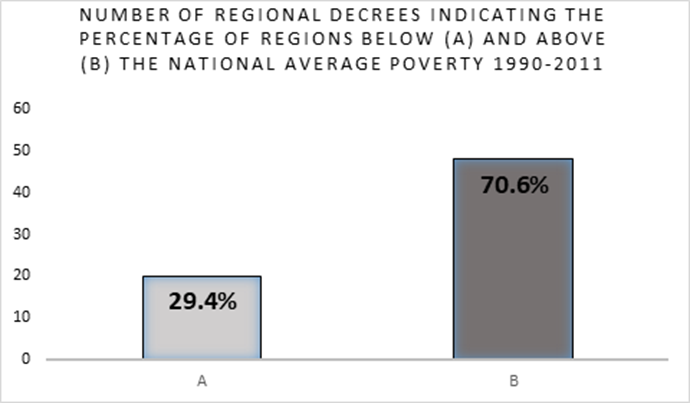
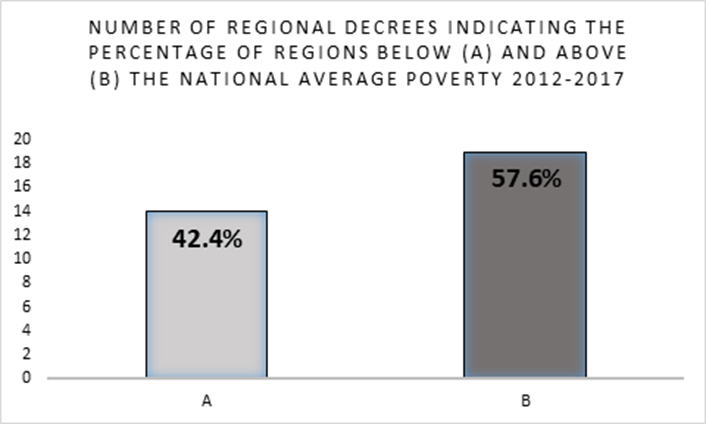
5 Analysis
The evidence shows that disasters change with geography and evolve in time. In the case of Chile, it is possible to observe an increase in disasters of anthropic origin, which territorial distribution is linked to the geographic features and the productive sectors of each territory. For example, forest fires seem to increase in areas dedicated to the forest industry, and droughts seem to increase in areas where mining and agriculture based on foreign species represent the main industrial activity.
In the 1990s, 3 drought events were counted. But in the period 2010-2017, 7 events of that type occurred. A similar situation is observed regarding forest fires; during the 1990s only one event occurred. In the period 2000-2010 also one forest fire event was counted, but between 2011 and 2017, 7 decrees of emergencies caused by forest fires were counted. These events suggest a link between extreme hydrometeorological events and water scarcity, especially in regions dominated by the forestry industry. This observation is not new. There has been previous research on this topic, reaching similar conclusions; for example, Aguayo, 2015, describes the conflict between the forest industry in Chile, where monoculture forestry dominates, and the co-existing, marginalized peasant agriculture.
The increase in the number of disasters, not only relates to global change, but also to the capability of the territories to adapt to these risks or to reduce them, keeping in mind that these decrees of emergency represent political tools administered by the government in force. Therefore, studying the occurrence of natural disasters from the perspective of this instrument allows for understanding the degree of readiness and management the country possesses.
There are four metropolitan areas in Chile, composed of conurbations located in Coquimbo, Valparaiso, Biobio and the Metropolitan Region where the capital, Santiago, is located. The regional concentration of disasters, shows in figure 4, that 40% of all the disasters occurred in these 4 metropolitan areas (i.e. the disasters seem to concentrate in 4 of the 15 regions of the country). This would imply there is a tendency to declare a state of emergency in urban zones which are densely populated, or at least in regions with large urban zones.
However, it is interesting to note that this tendency is not true for the Metropolitan Region of Santiago, where more than 40% of the whole population of Chile lives. Two factors could influence this outcome: on one side, this is a zone characterized by an economy based on services rather than extraction of natural resources; on the other hand, the country is excessively centralized, causing a situation in which this region has the highest urban and social investment, far above the rest of the country.
Between 1990 and 2017 only 3 decrees of emergency were issued for the Metropolitan Region. This region also, consistently, presented poverty indices well below the national figures. This reveals how the distribution of resources and the centralized political power influences the territorial capabilities for disaster risk management. This fact is consistent with one of the main results found in this study (figure 6), which show that most of the events occurred in regions where the percentage of people living in poverty was higher than that of the country as a whole. This tendency is particularly strong between 1990 and 2011, and less clear, although still following the same trend, between 2012 and 2017.
It is not clear whether the difference between these two periods is related to the changes introduced in the CASEN methodology or whether it is an artefact of the sample size; however, the reasons may be related to topics of interest in the field of Social Work. First, regarding the methods used to measure poverty, and how these methods and the priority given to certain variables influence the way we understand territorial divisions. In other words, this suggests that poverty is a flexible and dynamic concept, which needs to be constantly and critically reviewed. Secondly, phenomena such as global change and the accelerated degradation of ecosystems where urban and rural settlements are located, have an influence on the emergence of bigger scale and more massive natural disasters, which impact areas which had never been affected before.
Even though it is accepted that people who live in poverty are the most vulnerable regarding disasters, this study suggests that during the second period studied here (2011-2017), the conditions of exposure and vulnerability to risks deepen, beyond the concept of income poverty; this suggests the existence of new complexities at the moment of investigating or evaluating social work interventions oriented to territorial planning, environmental conflict and disaster risk management.
6 Conclusions
The study confirms the existence of a link between poverty and natural disasters. Just as it happens on a global level, the majority of the natural disasters found with the methodology used, occurred in administrative regions of the country where the percentage of people under the poverty line was higher than the poverty percentage of the whole country.
The negative impact of these phenomena is influenced by factors such as the high degree of development some territories possess, as compared to the vulnerability and inequity that characterizes other zones. The ways of measuring poverty also are determinant and it is necessary to maintain a constant vigilance on the ways in which governments estimate poverty, both economic and multidimensional. Often the measures are based on contradictory methodologies that do not allow a wider vision and do not reflect the reality of the territories and communities. Workers must participate more strongly in methodological decision that measure poverty.
In the case of Chile, natural disasters are dominated by extreme hydro-meteorological events, mainly floods and extensive droughts, both in the time and space dimensions. Due to human activity and also due to natural factors, both the productive and geographical set-up of a territory transform water into a natural resource under pressure. This seems to be particularly clear regarding forest fires; the magnitude and frequency odf this type of event has increased dramatically in the last decade, and their location suggests a link to territories where the forest industry is dominant, with the subsequent disturbances on the ecosystems, imposed by the replacement of native species by foreign, more productive or suitable species for the industry.
The Anthropocene generates deep transformations on the ecosystems and the relationships between human settlements and nature. It becomes relevant, in the field of Social Work, to consider the complexities of natural disasters and understand them as a social expression of poverty and environmental injustice. In its turn, it is unavoidable that social work considers NDs in an interdisciplinary manner and connects the diverse dimensions that comprise a disaster, as much in a social level as a geoplitical one.
The revision of Chilean NDs beginning with the decree of catastrophe zones, is an action that strengthens the pre-existing data for future analysis and diagnostics, facilitating the governing of the risk of disasters as well as strengthening the critical view of the tensions and paradoxes in the ways of measuring poverty. More social workers should use these types of estimations in their territories, cross-referencing available data to have a more precise knowledge of the socio-ecological vulnerabilities and risks of their region. The participation of social workers in the characterization of the ND according to territory, offers new points of view other than the vertical and centralized views to measure and understand the ND, for example, incorporating a gender perspective, the value of local or ancestral knowledge and the ontologies about nature.
References:
Aguayo, B. (2015). Economías campesinas, industria forestal e incendios: inestabilidad socionatural y la agricultura como resistencia. Ambiente & Sociedade, 18(1), 93-114. https://dx.doi.org/10.1590/1809-4422ASOC720V1812015esp.
Alcantara-Ayala, I. (2016). On the multi dimensions Integrated Research on Landslide Disaster Risk. En Aversa et al (Eds.). Landslides and Engineered Slopes Experience, thery and Practice. Roma, Italia: Associazione Geotecnica Italiana.
Arga, B., Walsh, J., Rozenberg, J., & Hallegatte, S. (2020). Revised Estimates of the Impact of Climate Change on Extreme Poverty by 2030. http://documents1.worldbank.org/curated/en/706751601388457990/pdf/Revised-Estimates-of-the-Impact-of-Climate-Change-on-Extreme-Poverty-by-2030.pdf.
Arouri, M., Nguyen, C., & Youssef, A. (2015). Natural disasters, household welfare, and resilience: Evidence from rural Vietnam. World Development, 70, 59-77. doi:10.1016/j.worlddev.2014.12.017.
Balasubramanian, M. (2018). Climate change, famine, and low-income communities challenge sustainable development goals. The Lancet Planetary Health, 2(10), e421-e422. doi:10.1016/S2542-5196(18)30212-2.
Bell, F. M., Dennis, M. K., & Krings, A. (2019). Collective survival strategies and anti-colonial practice in ecosocial work. Journal of Community Practice, 27(3-4), 279-295. doi:10.1080/10705422.2019.1652947.
Boetto, H. (2017). A transformative eco-social model: Challenging modernist assumptions in social work. British Journal of Social Work, 47(1), 48–67. https://doi.org/10.1093/bjsw/bcw149.
Bronfman, N. C., Cisternas, P. C., Repetto, P. B., & Castañeda, J. V. (2019). Natural disaster preparedness in a multi-hazard environment: Characterizing the sociodemographic profile of those better (worse) prepared. PLoS ONE 14(4): e0214249. https://doi.org/10.1371/journal.pone.0214249.
Bündnis Entwicklung Hilft (2018). The World Risk Reporthttps://weltrisikobericht.de/english/.
Bündnis Entwicklung Hilft and Ruhr University Bochum – Institute for International Law of Peace and Armed Conflict. (2019). WorldRiskReport 2019. https://weltrisikobericht.de/wp-content/uploads/2019/09/WorldRiskReport-2019_Online_english.pdf.
Capacci, A., & Mangano, S. (2015). Natural Disasters. Cuadernos de Geografía - Revista Colombiana de Geografía, 24(2), 35-51. https://dx.doi.org/10.15446/rcdg.v24n2.50206.
Carter, M. R., Little, P. D., Mogues, T., & Negatu, W. (2007). Poverty traps and natural disasters in Ethiopia and Honduras. World Development, 35(5), 835-856 doi:10.1016/j.worlddev.2006.09.010.
Consejo Nacional de Innovación para el Desarrollo (2016). Hacia un chile resiliente frente a desastres: Una oportunidad. Estrategia Nacional de Investigación, Desarrollo e Innovación para un Chile resiliente frente a desastres de origen natural. Recuperado de http://www.cnid.cl/wp-content/uploads/2016/12/INFORME-DESASTRES-NATURALES.pdf.
CRED Network (2009). EM-DAT: The International Disaster Database. http://www.emdat.be/.
CRED. (2019). Natural disaster 2018. Recuperado de https://www.cred.be/publications.
Das, A. (2020). Social work, disasters and communities - challenging the boundaries of the profession. British Journal of Social Work, 50(8), 2452-2465. doi:10.1093/bjsw/bcaa214.
Descola, P. (2014). Beyond Nature and Culture.USA: University of Chicago Press
Dilley, M., Chen, R., Deichmann, U., Lerner-Lam, A.. & Arnold, M. (2005). Natural Disaster Hotspots: A Global Risk Analysis. Washington: World Bank.
Dominelli, L. (2015). The opportunities and challenges of social work interventions in disaster situations. International Social Work, 58(5), 659-672. doi:10.1177/0020872815598353.
Drolet, J. (2015). Disasters in Social, Cultural and Political Context. International Encyclopedia of the Social & Behavioral Sciences, 478–484. doi:10.1016/b978-0-08-097086-8.28060-4
Dunlap, E., & Golub, A. (2011). Drug markets during the katrina disaster. Disaster Prevention and Management: An International Journal, 20(3), 251-265. doi:10.1108/09653561111141709.
Ffrench-Davis, R., & Díaz, A. (2019). La inversión productiva en el desarrollo económico de Chile: evolución y desafíos. Revista CEPAL, 127, p. 27-53. Recuperado en https://repositorio.cepal.org/bitstream/handle/11362/44571/RVE127_Ffrench-Davis.pdf?sequence=1&isAllowed=y.
Frankenberg, E., Sumantri, C., & Thomas, D. (2020). Effects of a natural disaster on mortality risks over the longer term. Nature Sustainability, 3(8), 614-619. doi:10.1038/s41893-020-0536-3.
Fussell, E., & Lowe, S. R. (2014). The impact of housing displacement on the mental health of low-income parents after hurricane Katrina. Social Science and Medicine, 113, 137-144. doi:10.1016/j.socscimed.2014.05.025.
Germanwatch (2018). Global Climate Risk Index 2018. https://germanwatch.org/es/node/14987.
Hidalgo M., Burgos C., & González G. (2018). Alluvions in Ravine Wetland Socio-ecosystems: Ecological Resilience and Social Vulnerability in Iquiuca-Parca, Tarapaca Region (Chile). In: Leal Filho W., Esteves de Freitas L. (Eds.) Climate Change Adaptation in Latin America. Climate Change Management. Springer, Cham.
ICTA UAB. (2019). Mapas de Justicia ambiental. Recuperado de https://ejatlas.org/.
Jacobs, F. (2019). Black feminism and radical planning: New directions for disaster planning research. Planning Theory, 18(1), 24-39. doi:10.1177/1473095218763221
Jones, D. N., & Truell, R. (2012). The global agenda for social work and social development: A place to link together and be effective in a globalized world. International Social Work, 55(4), 454–472. https://doi.org/10.1177/0020872812440587.
Kapadia, K. (2013). Producing entrepreneurs in sri lanka's post-tsunami economy: Re-thinking the relationships between aid, knowledge and power. Contemporary South Asia, 21(1), 6-21. doi:10.1080/09584935.2012.757580.
Klein, N. (2007) La doctrina del shock: el auge del capitalismo del desastre. Barcelona: Ed. Paidós.
Krings, A., Victor, B. G., Mathias, J., & Perron, B. E. (2018). Environmental social work in the disciplinary literature, 1991–2015. International Social Work, 002087281878839. doi:10.1177/0020872818788397.
Larminat, P. (2016). Earth climate identification vs. anthropic global warming attribution. Annual Reviews in Control, Volume 42, 114-125.
Lee, C., & Tang, C. F. (2019). How do natural disasters influence the rate of poverty? Journal of Poverty, 23(6), 478-486. doi:10.1080/10875549.2019.1616033.
Lim, J., Loveridge, S., Shupp, R., & Skidmore, M. (2017). Double danger in the double wide: Dimensions of poverty, housing quality and tornado impacts. Regional Science and Urban Economics, 65, 1-15. doi:10.1016/j.regsciurbeco.2017.04.003.
Maglajlic, R. A. (2019). Organisation and delivery of social services in extreme events: Lessons from social work research on natural disasters. International Social Work, 62(3), 1146-1158. doi:10.1177/0020872818768387.
Mason, L. R., Shires, M. K., Arwood, C., & Borst, A. (2017). Social Work Research and Global Environmental Change. Journal of the Society for Social Work and Research, 8(4), 645–672. doi:10.1086/694789.
Naciones Unidas (2015). Marco de Sendai para la Reducción del Riesgo de Desastres 2015-2030. Recuperado de https://www.unisdr.org/files/43291_spanishsendaiframeworkfordisasterri.pdf.
Observatorio de Conflictos mineros de América Latina (2019). Mapa de Conflictos mineros en América Latina. Recuperado de, https://mapa.conflictosmineros.net/ocmal_db-v2/.
Owens, T. T., Hoddinott, J., & Kinsey, B. (2003). Ex-ante actions and ex-post public responses to drought shocks: Evidence and simulations from zimbabwe. World Development, 31(7), 1239-1255. doi:10.1016/S0305-750X(03)00068-8.
Park, A. & Wang, S. (2017). Benefiting from disaster? Public and private responses to The Wenchuan earthquake. World Development, 94, 38-50. doi:10.1016/j.worlddev.2016.12.038.
PNUD. (2017). Desiguales. Orígenes, cambios y desafíos de la brecha social en Chile. Santiago de Chile: Programa de las Naciones Unidas para el Desarrollo.
Reininger, B. M., Rahbar, M. H., Lee, M., Chen, Z., Alam, S. R., Pope, J. & Adams, B. (2013). Social Capital and Disaster preparedness among Low income Mexican Americans in a disaster prone area. Social Science and Medicine, 83, 50-60. doi:10.1016/j.socscimed.2013.01.037.
Sawada, Yasuyuki & Takasaki, Y. (2017). Natural Disaster, Poverty, and Development: An Introduction, World Development, Elsevier, vol. 94(C), pages 2-15.
Van Heugten, K. (2014). Human service organizations in the disaster context. Basingstoke: Palgrave Macmillan.
Vásquez, W. F., & Bohara, A. K. (2010). Household shocks, child labor, and child schooling: Evidence from Guatemala. Latin American Research Review, 45(3), 165-186.
Waters, M. C. (2016). Life after hurricane Katrina: The resilience in survivors of Katrina (RISK) project. Sociological Forum, 31, 750-769. doi:10.1111/socf.12271.
Webb, P. (2003). The uncertain path of transition: Food, nutrition and poverty dynamics in southeast Asia. Quarterly Journal of International Agriculture, 42(3), 273-292.
Wickramasinghe, K. (2013). Role of Social Protection in Disaster Management in Sri Lanka. Sri Lanka journal of social sciences. 35/36. 1. 10.4038/sljss.v35i1-2.7297.
Yan, T., Zhang, T., & Zhang, J. (2017). Research on natural disaster vulnerability and its poverty-causing effect in contiguous poor rural areas. Chinese Journal of Agrometeorology, 38(8), 526-536. doi:10.3969/j.issn.1000-6362.2017.08.007.
Author´s
Address:
Elia Sepúlveda Hernández
University Santo Tomas, La Serena, Chile
eliasepulvedahe@santotomas.cl
Author´s
Address:
Roxana Contreras
Arctic Centre
University of Lapland
rpcontre@gmail.com
Author´s
Address:
Ma. Alejandra Mora Castillo
Department of Social Work. Faculty of Legal and Social Sciences
University of Atacama, Chile
alejandra.mora@uda.cl